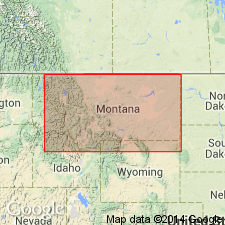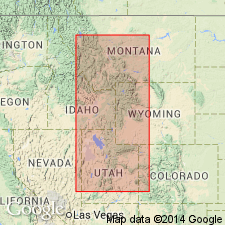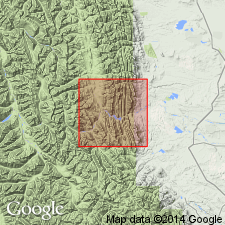
- Usage in publication:
-
- Dearborn limestone
- Modifications:
-
- Original reference
- Dominant lithology:
-
- Limestone
- Shale
- AAPG geologic province:
-
- Montana folded belt
Summary:
Pg. 36 and passim. Dearborn limestone. At type locality can be roughly divided into (descending): (1) irregularly bedded, platy dull-gray fine-grained limestones in beds averaging 1 inch in thickness, interbedded with thin olive-gray calcareous shale in upper part, 127 feet; (2) massive, thick-bedded crumbly gray argillaceous limestones with flakes and nodules of buff and some orange clay, 152 feet; (3) thin-bedded micaceous gray-buff shaly limestones with green-gray micaceous calcareous shale in upper fourth, 180 feet. Thickest (459 feet) in Dearborn region; thinnest (135 feet) in vicinity of Prairie Reef. Overlies Nannie Basin limestone and underlies Steamboat limestone. Age is Middle(?) Cambrian.
Type locality: North Fork of Dearborn River, in W/2 sec. 6, T. 17 N., R. 7 W., [south-central part of Lewis and Clark Range, Lewis and Clark Co.], northwestern MT.
Source: US geologic names lexicon (USGS Bull. 896, p. 578-579).

- Usage in publication:
-
- Dearborn limestone
- Modifications:
-
- Revised
- AAPG geologic province:
-
- Montana folded belt
Summary:
Pg. 1075, 1081-1082, 1086, 1089, 1090 (fig. 2); 1939, GSA Spec. Paper 18, p. 26, 30, 33, 40, 54 (fig. 6). Dearborn limestone. As herein defined, conformably overlies Damnation limestone (redefined) and conformably underlies Pagoda limestone. Steamboat limestone, as used in 1933 sequence, has proved to be part of massive upper Dearborn which was repeated in the Dearborn section by low angle overthrust. Steamboat as now used refers to limestone underlying Switchback limestone and overlying Pentagon shale. Thickness at type locality 354 feet. Consists of lower shaly interval and a much thicker upper limestone interval. [Age is Middle Cambrian (Albertan).]
Type locality: on north side of valley of North Fork of Dearborn River, in W/2 sec. 6, T. 17 N., R. 7 W., south-central part of Lewis and Clark Range, Lewis and Clark, Co., northwestern MT.
Source: US geologic names lexicon (USGS Bull. 1200, p. 1059).

- Usage in publication:
-
- Dearborn Limestone*
- Modifications:
-
- Areal extent
- AAPG geologic province:
-
- Montana folded belt
- Sweetgrass arch
Summary:
Pg. A6-A7 (table 1), A23. Dearborn Limestone. Subdivided into (descending): (1) upper, limestone member, finely crystalline pale-yellowish-brown very thin irregularly bedded limestone, about 145 feet thick; and (2) lower, mudstone member, calcareous shale and many thin limestone beds, about 150 feet thick. Underlies Pagoda Limestone; overlies Damnation Limestone. Age is Middle Cambrian.
Source: Publication.
For more information, please contact Nancy Stamm, Geologic Names Committee Secretary.
Asterisk (*) indicates published by U.S. Geological Survey authors.
"No current usage" (†) implies that a name has been abandoned or has fallen into disuse. Former usage and, if known, replacement name given in parentheses ( ).
Slash (/) indicates name conflicts with nomenclatural guidelines (CSN, 1933; ACSN, 1961, 1970; NACSN, 1983, 2005, 2021). May be explained within brackets ([ ]).

